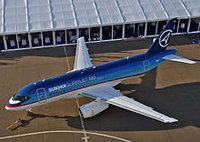
Debris of Sukhoi Superjet-100 found. No sign of survivors reported

The debris of Russia's Sukhoi Superjet-100 has been found in Indonesia. The state-of-the-art airplane went off radar screens yesterday as the plane was performing a demonstration flight in Indonesian capital Jakarta. Indonesian President Susilo Bambang Yudhoyono confirmed the crash of the plane at a news conference Thursday and demanded meticulous investigation be conducted to find out the causes that had led to the crash.
"Rescuers on the helicopters could clearly see the wreckage located at the top of Mount Salak," including the blue-and-white of the aircraft maker, says Gagah Prakoso, a spokesman for the Search and Rescue National Agency.
"There is no sign of any of the passengers," he said, adding the helicopters are trying to move closer to the wrechage now, RT reports.
The 48 people onboard included Indonesian businessmen, Russian embassy officials and journalists. Earlier reports suggested the plane took off with 50 people, but then it proved two Indonesian men had decided to skip the demonstration flight.
The Sukhoi Superjet 100 is a modern regional jet in the 75- to 95-seat category. With development starting in 2000, the airliner was designed by the civil aircraft division of the Russian aerospace company Sukhoi in co-operation with Western partners.
In the Russian domestic market, the Sukhoi Superjet 100 (SSJ) is intended to replace the aging Tupolev Tu-134 and Yakovlev Yak-42 planes. Internationally, the new Superjet 100 will compete against theEmbraer E-Jets and the Bombardier CRJ programs. The SSJ aims for lower operating costs than its competitors for the price of $23-25 million. According to Sukhoi, ongoing certification tests are confirming that the aircraft's direct operating costs are 6-8% lower than those of its key competitor, the Embraer 190/195. In terms of total fuel burn per sector, the SSJ is on a par with the Antonov An-148but can accommodate 22 more passengers.
The aircraft's design meets the specific requirements of airlines in Russia, the CIS, the USA and the EU, and conforms to the Aviation Rules AP-25, FAR-25, JAR-25 requirements and to the ground noise level requirements under ICAO Chapter 4 and FAR 36 Section 4 standards entering into force during 2006. From the beginning, the SSJ has been designed to meet all Western aviation standards.